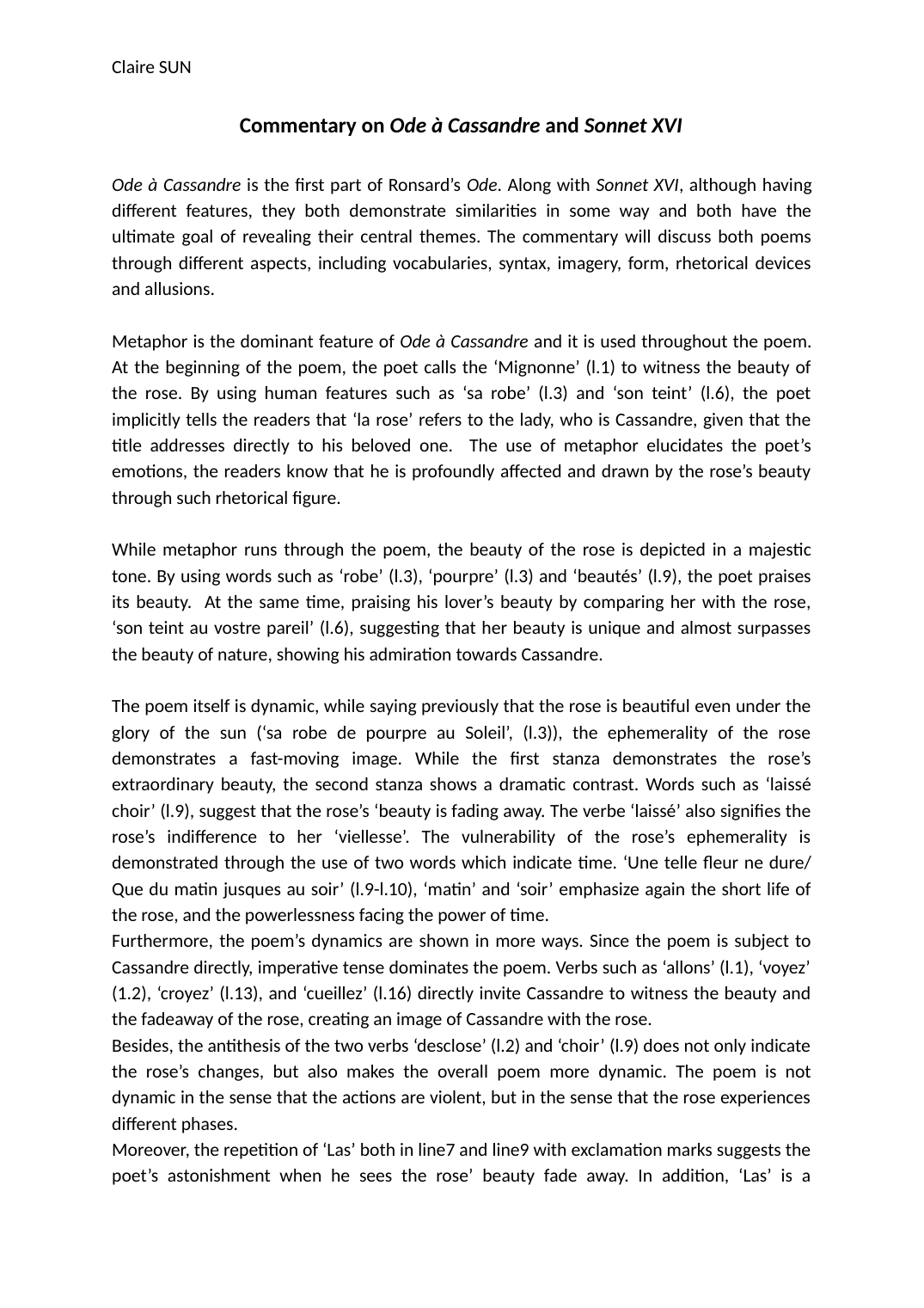?Commentary on Ode à Cassandre and Sonnet XVIOde
Publié le 23/05/2020

Extrait du document
Ode Ce document contient 1593 mots soit 4 pages. Pour le télécharger en entier, envoyez-nous un de vos documents grâce à notre système gratuit d’échange de ressources numériques. Cette aide totalement rédigée en format pdf sera utile aux lycéens ou étudiants ayant un devoir à réaliser ou une leçon à approfondir en Littérature.
«
Claire SUN
Commentary on Ode à Cassandre and Sonnet XVI
Ode à Cassandre is the first part of Ronsard’s Ode .
Along with Sonnet XVI , although having
different features, they both demonstrate similarities in some way and both have the
ultimate goal of revealing their central themes.
The commentary will discuss both poems
through different aspects, including vocabularies, syntax, imagery, form, rhetorical devices
and allusions.
Metaphor is the dominant feature of Ode à Cassandre and it is used throughout the poem.
At the beginning of the poem, the poet calls the ‘Mignonne’ (l.1) to witness the beauty of
the rose.
By using human features such as ‘sa robe’ (l.3) and ‘son teint’ (l.6), the poet
implicitly tells the readers that ‘la rose’ refers to the lady, who is Cassandre, given that the
title addresses directly to his beloved one.
The use of metaphor elucidates the poet’s
emotions, the readers know that he is profoundly affected and drawn by the rose’s beauty
through such rhetorical figure.
While metaphor runs through the poem, the beauty of the rose is depicted in a majestic
tone.
By using words such as ‘robe’ (l.3), ‘pourpre’ (l.3) and ‘beautés’ (l.9), the poet praises
its beauty.
At the same time, praising his lover’s beauty by comparing her with the rose,
‘son teint au vostre pareil’ (l.6), suggesting that her beauty is unique and almost surpasses
the beauty of nature, showing his admiration towards Cassandre.
The poem itself is dynamic, while saying previously that the rose is beautiful even under the
glory of the sun (‘sa robe de pourpre au Soleil’, (l.3)), the ephemerality of the rose
demonstrates a fast-moving image.
While the first stanza demonstrates the rose’s
extraordinary beauty, the second stanza shows a dramatic contrast.
Words such as ‘laissé
choir’ (l.9), suggest that the rose’s ‘beauty is fading away.
The verbe ‘laissé’ also signifies the
rose’s indifference to her ‘viellesse’.
The vulnerability of the rose’s ephemerality is
demonstrated through the use of two words which indicate time.
‘Une telle fleur ne dure/
Que du matin jusques au soir’ (l.9-l.10), ‘matin’ and ‘soir’ emphasize again the short life of
the rose, and the powerlessness facing the power of time.
Furthermore, the poem’s dynamics are shown in more ways.
Since the poem is subject to
Cassandre directly, imperative tense dominates the poem.
Verbs such as ‘allons’ (l.1), ‘voyez’
(1.2), ‘croyez’ (l.13), and ‘cueillez’ (l.16) directly invite Cassandre to witness the beauty and
the fadeaway of the rose, creating an image of Cassandre with the rose.
Besides, the antithesis of the two verbs ‘desclose’ (l.2) and ‘choir’ (l.9) does not only indicate
the rose’s changes, but also makes the overall poem more dynamic.
The poem is not
dynamic in the sense that the actions are violent, but in the sense that the rose experiences
different phases.
Moreover, the repetition of ‘Las’ both in line7 and line9 with exclamation marks suggests the
poet’s astonishment when he sees the rose’ beauty fade away.
In addition, ‘Las’ is a.
»
↓↓↓ APERÇU DU DOCUMENT ↓↓↓
Liens utiles
- Pierre de Ronsard Ode à Cassandre Mignonne, allons voir si la rose Qui ce matin avait déclose Sa robe de pourpre au soleil, A point perdu, cette vêprée, Les plis de sa robe pourprée Et son teint au vôtre pareil.
- Do you believe that pop culture has made women nudity and body an object ?
- The danger of space exploration on the human body and the environment
- ART AND POWER
- Oral anglais Master and servants


